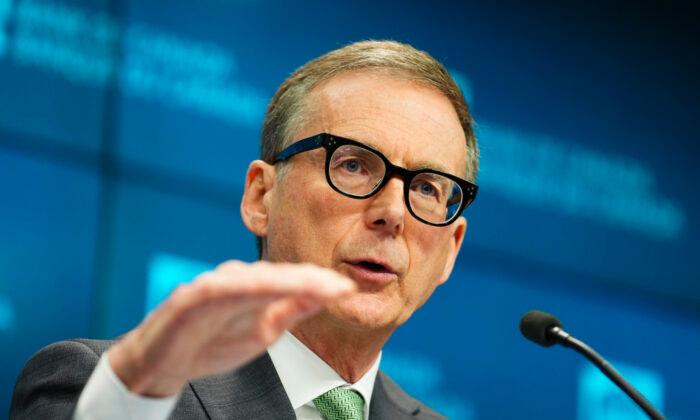OTTAWA—Now is the time when the full effect of the Bank of Canada’s earliest interest rate hikes in 2022 are starting to take effect. While Canada’s central bank was caught off guard by a surprisingly strong first quarter of economic growth, it expects much weaker albeit slightly positive growth for the rest of the year.
“We’re not forecasting a major contraction. We’re not forecasting large increases in unemployment. And in that sense, it’s not what people associate with the word recession,” Bank of Canada Governor Tiff Macklem told reporters on April 12.
But some economists believe that when the full brunt of the 4.25 percentage points of rate hikes takes effect, the Canadian economy will plunge into a recession.
“We forecast much weaker GDP [gross domestic product] growth in 2023 than the BoC. We expect the economy will slip into recession beginning in Q2 as the full impact of past interest rate hikes work through the economy, credit tightens due to the recent banking sector turmoil, and the U.S. enters recession,” said Michael Davenport, economist at Oxford Economics, in a note.
The BoC projects economic growth of 1.4 percent for 2023—up from 1.0 percent in January. The growth forecast for 2024 fell sharply from 2 percent to 1.3 percent. The bank upgraded its forecast for first-quarter 2023 growth significantly to 2.3 percent up from just 0.5 percent in January.
The timing of economic growth is essentially being shifted into 2023 at the expense of the final quarter of 2022 and calendar year 2024.
Recession Evaluation
Oxford Economics forecasts Canada’s GDP will contract 0.3 percent in 2023.
“Typically, we think that monetary policy has its maximum effect between 12 and 18 months. So we are in that zone where we normally see a lot of effects from past increases in interest rates,” Jean-Paul Lam, University of Waterloo economics professor and former Bank of Canada assistant chief economist, told The Epoch Times.
Housing was the quickest to respond to the rate hikes, and the BoC said real estate activity remains subdued.
Now, as interest rates really start to bite, the bank said big-ticket items are seeing less demand, and business investment is falling.
The labour market, however, is only showing minor signs of any impact from the rate hikes in that shortages are starting to ease, according to the bank’s survey data.
Macklem said a period of weak growth, which is expected in the last three quarters of 2023, is needed to obtain a better balance between supply and demand.
According to economists with the C.D. Howe Institute’s Monetary Policy Committee, expectations for a recession are, while widespread, getting pushed further into the future than early-to-mid 2023, with the severity of it being milder.
But in 2024, the BoC forecasts an economic rebound to begin and for 2025 to see robust growth of 2.5 percent, with inflation back at the 2 percent target.
“Those effects of higher interest rates on growth are starting to fade, the global economy is picking up, there’s more export demand, with those things growth resumes. And keep in mind growth is going to be resuming with inflation around the 2 percent target,” Macklem said in response to a question from The Epoch Times.
Lam said external conditions such as growth in the United States and internationally will be the biggest factor supporting growth in Canada in 2025, as long as the BoC’s projections come true.
“We can have growth with a higher rate that we’ve seen in the past, and I think it’s basically because the external demand is going to be very strong,” Lam said.
No Plans to Cut Rates
The Bank of Canada, as widely expected, held its overnight rate target at 4.5 percent—consistent with the pause it announced in January.
Macklem pushed back against any market-implied rate-cut expectations.
“With inflation still well above our target, we continue to be more concerned about the upside risks [to inflation],” he said.
RBC senior economist Josh Nye said, “Our base case is for the BoC to remain on hold throughout 2023, and we think its next move is more likely to be a cut (early next year, in our view) than a hike.”
Deficit Spending Analyzed
The Bank of Canada compares the increase in spending across all levels of government with the economy’s potential growth rate. When government spending was increasing by 3.5 percent, as it did in the second half of 2022, it was higher than the economy’s potential growth rate and was thus fuelling inflation.
Lam says Budget 2023—even with significant deficit spending—was consistent with what the BoC was expecting as it didn’t throw off growth or inflation forecasts.
The $25 billion per year for the next three years in total government additional fiscal stimulus, represents just 2.5 percent in the first half of 2023, and it will slow from there. Thus it is more in line with the potential growth rate in the economy and is not expected to either boost or reduce inflation.
“Government spending plans are not contributing to the slowing of growth that you see in our projection, but at the same time, they’re not standing in the way of getting inflation back to the 2 percent target,” Macklem said.
“This projection incorporates those new fiscal plans. Growth slows, and inflation comes back to target by the end of 2024.”
Oxford Economics said on April 4 that the budget’s spending will only provide a modest lift to GDP and inflation in the near term but won’t be enough to prompt the BoC to raise rates.





